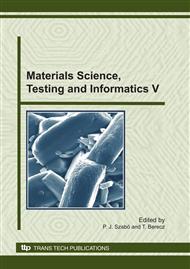p.283
p.289
p.295
p.301
p.307
p.313
p.319
p.325
p.331
Grain Boundary Investigation of AISI 304 Type Steel Using EBSD
Abstract:
This paper deals with the investigation of grain boundary engineering processes in case of AISI 304 type austenitic stainless steel. The effects of the thermo-mechanical treatments for the modification of the grain boundary structure are demonstrated on the special grain boundaries. The proper thermo-mechanical treatments can increase the fraction of the CSL-boundaries. Since the CSL-boundaries are resistant against intergranular degradation processes, materials owning enhanced properties can be developed due to these treatments. The investigation of the grain boundary character distribution is carried out by automated electron back scattered diffraction (EBSD) measurements after different thermo-mechanical treatment processes. The effect of the heat treatment duration on the grain boundary structure is examined; the optimal treatment is represented. It is shown by experimental results, that the parameter settings of the evaluation method strongly influence the obtained results.
Info:
Periodical:
Pages:
307-311
Citation:
Online since:
September 2010
Authors:
Price:
Сopyright:
© 2010 Trans Tech Publications Ltd. All Rights Reserved
Share:
Citation:


